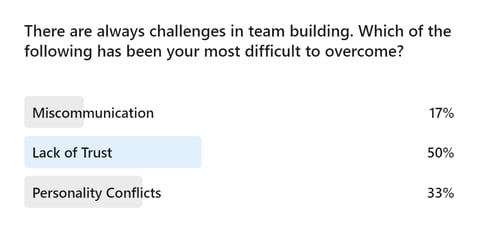It has been said the idea of trust is like opening an investment account. Once established, deposits are made over a period of time, and we expect the balance (trust) in the account to continue to compound and grow. If you’ve ever experienced the ups and downs of financial investing, you know there will be inevitable fluctuations, and times when the balance dips so low you begin to question whether you’re making the best financial decisions for yourself and your family.
Investing in relationships and building trust is like financial investing. You need patience, commitment for the long-term to develop or grow your investment portfolio with people who may not always be respectful of you but can become allies when they see how hard work pays off over time. One conversation leads just as easily into an unexpected setback than what was expected which brings us back full circle--trust isn't built overnight; it can take a significant investment of time.
When investing in relationships to build trust, the key is learning about the other person and identifying actions or behaviors that may indicate a hesitancy to reciprocate trust or perhaps highlight a breach of trust. Once it’s gone, it’s very difficult to regain! However, in both cases of investing, whether financial or people-oriented, we must trust FIRST before we see or experience the return on our investment. Abraham Lincoln once said,
“The people, when rightly and fully trusted, will return the trust.”
This can only be true if we can identify and address any barriers that can derail the process.
Barriers to Trust
Each DISC behavioral style has a specific dominant fear, and when you, as a leader, are attempting to build trust, it can be tricky to ease those fears and remove any barriers to trust.
- D styles fear being taken advantage of. This may be demonstrated by an unwillingness to delegate or collaborate on projects if they do not feel comfortable relinquishing control to someone else.
- I styles fear rejection. This may be demonstrated by an unwillingness to participate or take the lead during a team project if they do not feel accepted and recognized as a valuable teammate with valuable input.
- S styles fear loss of security. This may be demonstrated by an unwillingness to verbally articulate ideas or opinions to the team or leadership in fear of being drawn into conflict or viewed as ill-equipped for the job.
- C styles fear criticism. This may be demonstrated by an unwillingness to share information or communicate knowledge and details in fear of being viewed as lacking in technical knowledge or skill.
Trust Yourself First
When it comes to trusting FIRST, we must start by trusting ourselves. Don’t second-guess yourself and live in that moment; just trust you know you’re doing the right things. I trust in what we are doing. Is everything going to be successful? Probably not, as some things will change or not turn out as we had thought, but I trust we’re on the right course. We’re working towards solutions. I trust we are doing the right things, and that’s all you can do. Understand your strengths, fears, and motivators, and use them for good.
Trust Your Team

We posted a poll on LinkedIn asking which of the following has been the most difficult team building challenge to overcome. Interestingly, lack of trust was the most selected out of the three options.
You have to trust yourself and you have to trust your team. Understand your team’s strengths, fears, and motivators, and use them for good. If you do all the other steps leading up to this – you are aware, you see the needs of others, you’re keeping your virtues, keep encouraging, sharing - being transparent, taking time to explore travel with your mind, managing your expectations, educating yourself or others, living in the “now” – then you need to trust you’ve done the best job you’ve been able to do. You need to trust your instincts and your decisions.
Now, think of five people you love, trust, and spend most of your time with weekly. Take some time to reflect on how you came to build a relationship with them, the interactions you experienced, and how you came to trust them. Start investing in yourself and your team today by learning how to build and nurture trust in relationships at home and in the workplace.





